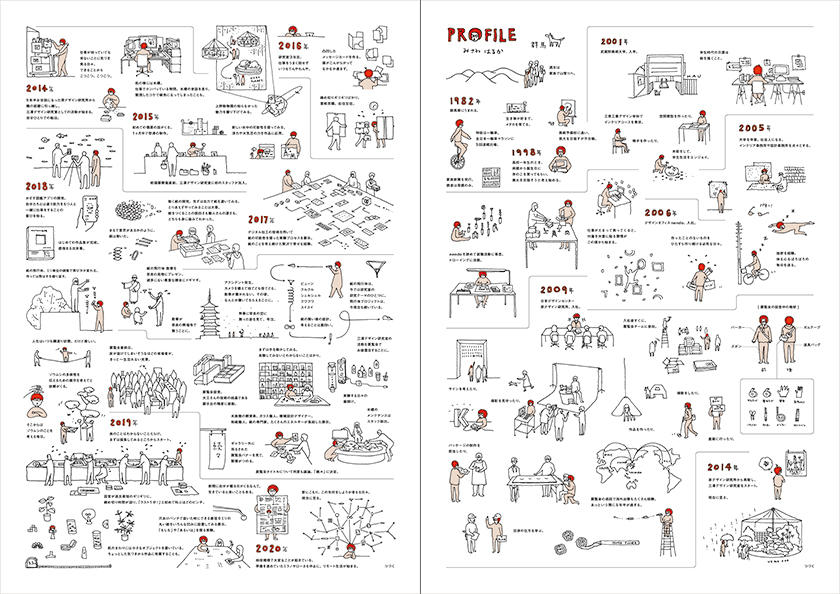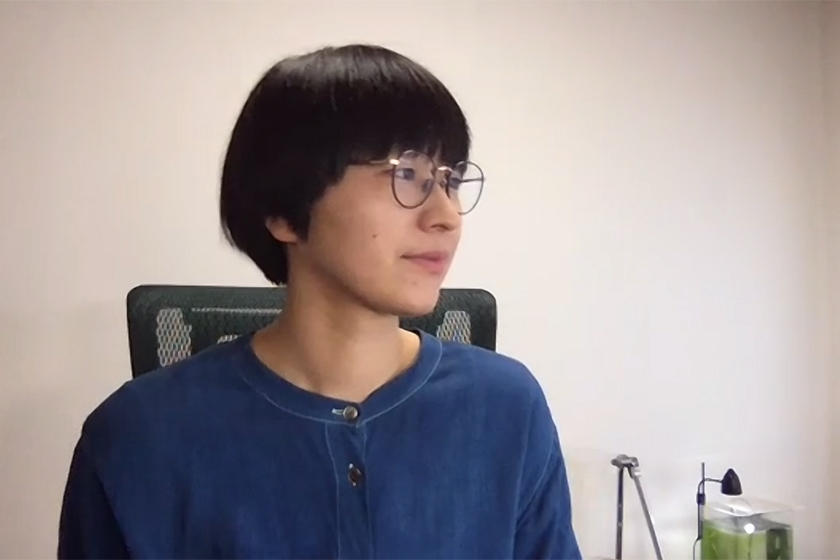

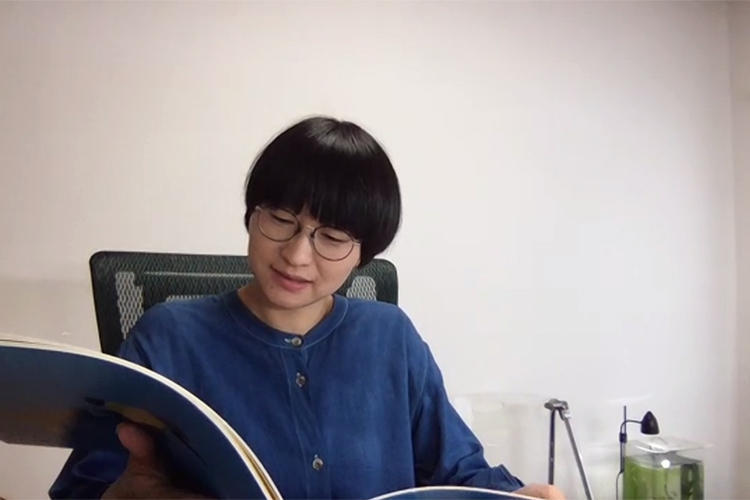
INTERVIEW
116
Haruka MisawaDesigner
Developing ideas for showing things in new ways
Design born from gazing at everyday life with the “new coronavirus”
A designer, Haruka Misawa is the winner of the 2019 Mainichi Design Awards, and anticipation is building for her work going forward. “Design inspired by current phenomenon,” her focus to date, presents a new way of perceiving and enjoying things that are close to us while also attempting to open up the possibilities beyond. This interview was conducted in the middle of April after a state of emergency had been declared in response to the new coronavirus and was thus held online using a video conferencing system. Now, with what was commonplace in the past no longer holding true today, what can be done for the post-coronavirus future? From Haruka’s candid and serious remarks, we search for hints about what the future may hold in store.
Looking toward the future while reminiscing about the past
In the past, I drew an illustration profiling my life from when I was born up to the opening of the Misawa Design Institute. This time, as I am at home a lot more now due to the new coronavirus, I continued with that theme, and, on a single piece of paper, summarized by life for the six years from opening the institute in 2014 to today. The first thing I thought about when drawing the illustration was the anxiety I felt when starting out alone as one person. However, gradually the number of staff increased, and I am now able to work with the help of many people. I wanted to draw a picture that condensed the fun and joy as well as the struggles I experienced creating things with the many talented people I have met.
Left page: 2014 - 2020 edition, right page: 1982 - 2014 edition
Illustration: Haruka Misawa (click on the image to enlarge it)
Illustration: Haruka Misawa (click on the image to enlarge it)
By creating this sort of archive of my life to date, I can look back at the past while also gazing toward the future. Usually, I am busy with the things right in front of me and don't really have a chance to reflect on the past. However, I think that drawing the last six years of my life also became a process for me to gaze into the future.
In April 2020, I was going to exhibit at Salone del Mobile.Milano and hold a solo exhibition as well. I spent close to one year steadily preparing together with my staff, so when Salone was canceled, my own activities also came to a sort of temporary halt. This provided me an opportunity to stop and think about where I wanted to go from here. I am quite sure that without the situation caused by the new coronavirus, I would not have stopped on my own accord. Up until now, working as a designer, I have been too scared to slow down or temporarily halt my activities. However, now there is pressure to "stop" on a global scale, so I am experiencing, for the first time, a situation in which I must stop. I don't want to call this fate, but I think being forced to stop may have provided me an opportunity to make a significant change or approach things from an angle different to that I have used to date.

Salone del Mobile.Milano International Furniture Fair
Salon del Mobile.Milano is a furniture fair held in the Italian city of Milano. It is the largest trade fair of its kind in the world and showcases the latest works by companies and designers from around the world. Milano Design Week is also held during the fair period, and numerous design-related exhibitions are held throughout the city. Due to the impact of the new coronavirus, the 2020 fair was postponed until 2021.
Courtesy Salone del Mobile.Milano, Saverio Lombardi Vallauri
Maintaining my ability to stay inspired
I was determined to make my exhibition at Salone an absolute success. Then, the fair was canceled due to the coronavirus. It was a big blow for me; however, at the same time, the virus is a very serious issue affecting everyone's lives. So, in light of that, I thought my mindset of I "must" ensure "absolute success" was rather trivial in comparison. I also have the ability to quickly adopt a "so-what, what's next" attitude (smiles). As a result, I developed a desire to "think of an idea that would achieve more results than would have been generated at the exhibition." In exploring new, deeper ideas, I want to create something that will be two or even three times more impactful than the original. And I want to make sure I do not lose my "ability to stay inspired."
I unveiled a work titled "Paper Verb" at the takeo paper show 2018 "precision." As the title suggests, I wanted to represent paper as a verb, meaning in action. It's not that the paper itself moves that is so interesting, but rather that it looks like it has a will and mind of its own, and I continue to explore that theme to this day. At first, the paper was just crawling around on the ground, but through repeated experimentation, we got it moving against gravity and crawling up walls and going along the ceiling.
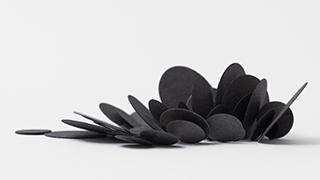
Paper Verb
A work unveiled at the takeo paper show 2018 "precision." Paper with metallic properties reacts to the forces of magnetism and moves around like an autonomous creature. The kanji characters used for the title represent motion + paper, and together are pronounced the same way as the kanji for "verb," thus the title has a double meaning. Paper, which is usually a static material, actively moves, thus showing the possibilities and roles of this new paper.
Photo: Masayuki Hayashi
The work I planned to unveil at Salone del Mobile.Milano was also going to be a paper installation. But now, while still using the movement of paper, I am beginning to shift my imagination, thinking that I can apply the concept to something other than an "installation." Before there was the new coronavirus, there was something I was trying to show; however, it has now become a "with corona and after corona world." Even if I make the same thing, it may be conveyed differently in this new normal. Even if I deal with the same theme ―paper that has a will and mind of its own― I must reconsider how to show it and from what perspective to frame it. Especially now, when it is difficult to directly "see" and "touch" things like before, I have to think about what I need to do to convey the allure and appeal of the work. What could work as a "new way of showing things?" That is what I am exploring right now.

Developing ideas for "showing things in new ways"
In addition to Paper Verb, other works produced by the Misawa Design Institute to date have not been things that you can understand in an instant when viewing from a distance or things that look cool at a glance. Rather, there are many that only slowly reveal themselves if you touch them with your hand or gaze directly at them. But now, the situation is not one where you can go and directly view designs and art at museums and galleries. So, how to create something "from here forward" is the most important issue right now. It's not just about holding a virtual exhibition or something like that. What is needed are "ideas for showing things in new ways." In other words, I feel it is necessary to develop ideas about "how I am going to show something" rather than ideas for exhibitions themselves.
How long will the coronavirus be an issue? Will it go on for a long time? Long enough to define an age? Right now, there are many things we do not know. Even when the opportunity for people to view works directly comes back, for a while, there will probably be rules limiting the number of people and ensuring distance between people is kept. I think it will be difficult to "go see something with a lot of people." In such a situation, rather than having "many" attendees view your work, how long to you want to have one person contemplate it becomes a question. I think a key point will be how to design the opportunity that will allow someone to view the work carefully and thoroughly without rushing. If that is the case, instead of someone going to see the work, it might be that it is delivered to their house, and they view it for a few days. Or, it may also be possible to create a system that allows a small number of people to view it outdoors, in the same way people look at a window display in the city.
Of course, this is all talk about after we get past this current urgent and life-threatening situation. However, being able to see something directly is of great value to both the creator and the person viewing their work. Thus, I definitely want such opportunities to come back. However, I feel that preparing for the next possibility is a challenge that has also been given to us designers.
A structure for experiencing each process and circumstance
The theme "district/community" forms the foundation of the Roppongi Future Conference. However, how to approach this going forward I believe is something that is very difficult to think about right now. The key may be in how to convey the individuality of each district with data that is different from what has been used to date.
Take Roppongi, for example; you could give it a boost by using something like a podcast to convey its value as a base for disseminating information. Someone could observe what is happening in the streets from one moment to the next and then communicate that in real-time. It may be a good idea to devise a workshop-like technique that allows someone to determine a theme, move about the city, and then give a detailed explanation, rather than having a "gathering."
For Roppongi museums as well, you could, for example, broadcast a video/images of the processes that go into creating a work. Ask the artist to go to the gallery and film the whole process from start to finish. It would be possible to plan how you wanted to transmit that. You could change the camera angle every day. On some days, you could just shoot the artist's hand. On others, use a bird's eye view and only shoot movements. You could also have days when the artists themselves uninterruptedly explain the original tools they use in the production of their works. If you could realize a structure, even experimentally, that allows people to experience the background and processes that go into creating a work, something that is not conveyed by just looking at a completed work, I think that in itself would probably be interesting.
People involved in design are regularly thinking about "how to show" something. Through their work, they are undergoing training on the best ways of showing things; without a doubt, I think ideas can be generated there. If that idea works well, a breakthrough might be achieved. It could serve as one criterion that everyone will reference, leading to the possibility that a new presentation format could be created.
Observing the "new normal"
I'm sure this is the same for everybody, but the new coronavirus has completely changed what is normal for me. We are conducting this interview remotely using Zoom, and until now, I had thought that online meetings were unreasonable. However, there were a lot of small discoveries that I made when I tried it.
There are many things that were out of the ordinary until now that have started to become ordinary. Even if this wasn't what you desired, they have become the "new normal." And because design is inseparable from everyday life, there are probably clues for new design in online meetings that are now becoming routine. There is currently a constraint in that we should not meet with people directly. However, it is precisely such restrictions that should serve as a base for fostering new design concepts. So, right now, let's fully experience something we normally can't. Let's diligently observe the new normal. That's what I think.
Talking a little more about my own experiences with the new normal, it's quite trivial but, up until now, I didn't eat at home that often. So now things like the enjoyment I get by watching someone cook from close by and the deliciousness of just-cooked rice are all fresh for me (laughs). Also, I have an aquarium in my house. However, when I was busy, it was green with algae. Even though I created a work titled waterscape, I couldn't see any -scape in my own aquarium! And I felt remorseful about that on a daily basis. Now, due to the current situation, I spend a lot more time at home, so I am thoroughly cleaning my aquarium and unhurriedly appreciating the marine life therein. Another thing, though I don't have a green thumb and have seldom bought potted plants until now, I am using this opportunity to try and successfully keep some.
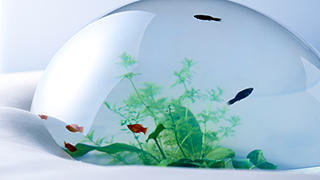
waterscape
A project aiming to recapture the ecological environment of aquatic life from scratch and explore the possibilities of new underwater landscapes. The aquarium, designed from a perspective of getting close to the ecology of marine life, was created using a 3D printer, die cutting, and blown glass. A comfortable environment for living creatures is delicately expressed with a minimalist design.
Photo: Masayuki Hayashi
Design born from small realizations
Currently, I think for me and everybody else, it is an unprecedented opportunity to gaze steadily at a particular thing. I thought about this the other day when I learned through the news that cultivating mushrooms at home was becoming popular. While you may be experiencing a lot of stress in your everyday life, if you get into the habit of fixedly staring at something in your home, you will notice a familiar happiness come over you. I think that there will be an increase in designs and jobs born from noticing these small things.
The coronavirus has entered our lives as a major problem. And, as a designer, I, of course, feel that I want to be "useful" as a designer. I have that feeling; however, from the beginning, I was conflicted about whether I wanted to make something right away that would be immediately useful. I have no medical expertise, and there is no easy way to approach delicate issues that even have the experts divided. Even if I make a protective facemask, the mask I make will be related to matters of life and death, and I can't take responsibility for that. Even if you can visualize a message that calls attention to something, information is changing from one minute to the next, and thus there is the fear that you could continually convey the wrong things. Although there are people who can thoroughly verify such things, unfortunately, I am not one of them....
So, how can I be of use? I believe times will change drastically. There will be "new ideas on how to show things," and a new awareness of everyday life. So, I would like to be of use by preparing for the post-coronavirus times.
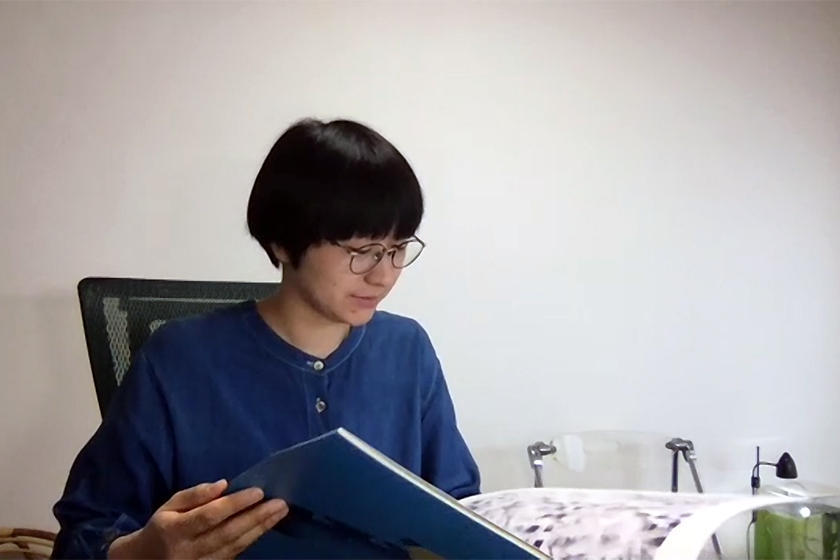
What had been only natural and routine to date, was in fact, not
As I stated at the beginning, I drew a profile of the most recent six years of my life. What I carefully thought about while drawing that was that my everyday life, which was "natural and a matter of routine" for me until now, was, in fact, not. It was unexpectedly better than I had thought it was. Now, I feel so happy when I can meet a staff member from whom I have been apart due to remote work. Especially when it comes to meeting people, now, I feel full of joy even if it is just a brief encounter.
Making things means "borrowing someone else's brain." That is what Kenya Hara, a designer and my former boss told me. Namely, instead of thinking about something alone, you should solidify your ideas by watching how people react to them. Change them by bouncing them off other people. No design can be constructed in your head alone. What you come to see while talking together with your staff or working on things together is what is important. At such times, the objectivity of the person beside you also gets interwoven into the product. Ideas change whether that person saw a dog that day or not; the daily lives of various people are connected like a web, there are designs in that. When it comes to making things as well, I hadn't thought about it until now because it seemed obvious, but I have been able to objectively recapture that value. What appears obvious is not so obvious, and I believe being aware of that is a positive sign.
There is a mixture of constant values and things that need to be changed in what has been commonplace to date. When we look back 50 or 100 years from now on the changes brought about by the coronavirus, I don't know how it will be positioned, but what did we want for the world going forward? What did we aim for? What did we endeavor to make? I think that will be tested in the history we make going forward. So, maybe now is the time to figure that out.
Continuing with change
In 2018, when I exhibited a work title Again and Again at the ginza graphic gallery, I asked Kenya Hara for a written contribution about the exhibition. I asked him to write something that "I could re-read when I stopped working or wanted to quit being a designer." Now, as I look back at things while the situation caused by the coronavirus is upon us, I remembered what he had written.
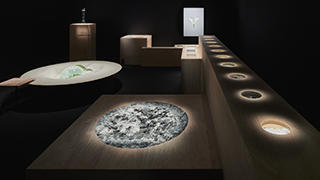
Again and Again: Ideas Coming To Mind, Haruka Misawa
A solo exhibition held by Haruka at the ginza graphic gallery (ggg) in 2018. Looking back upon the works presented by the Misawa Design Institute over the previous five years, she revealed her intent to "change again and again" while also exploring possibilities for the future. The exhibition consisted of eleven past projects including waterscape, Paper Verb and UENO PLANET, and it allowed viewers to fully experience new ways of capturing and enjoying familiar things, Haruka's specialty.
Photo: Junpei Kato
The content is very personal and contained parts, where he talked about my abilities, like Misawa can ride a unicycle, and she can use a thread saw; that was the main focus. Essentially, however, he encouraged me to maintain my motivation for making things so that I would continue to act in accord with the exhibition's title, Again and Again. The esteemed graphic designer Kazumasa Nagai also said I should continue while destroying things. He said to destroy the stereotypes I held, and in a good way to betray those around me. I am remembering what various people have told me and am now implementing what they said.
In the spring of this year, 2020, I won the Mainichi Design Awards, this was a major event in my life. In order to create something that will exceed the praise and expectations I received, the award has helped me to think calmly about what it is I want to do in the future. Additionally, I do not want to waste this valuable time for thinking that the coronavirus has forced upon me. I would like to continue with the challenge of working as a designer while carefully observing the various things around me ―a changing world and unchanging universal beauty.
Editor's thoughts
As mentioned at the beginning, an online video conferencing system was used to conduct the interview this time. Of course, everyone wants the situation with the new coronavirus to be resolved as quickly as possible and is committed to successfully dealing with an everyday life that has various restrictions placed upon it. Against such a backdrop, it is challenging to think about the "future that lies ahead." However, in the online interview, which lasted for about 90 minutes, I was able to find many words of encouragement from Haruka's calm observations and immensely optimistic attitude while her cute smile filled the screen. I hope the next time we meet, it will be in person so I can talk with her face to face. (text_tami okano)
Note: The image comprises screenshots taken during the online interview.
RANKING
ALL
CATEGORY




